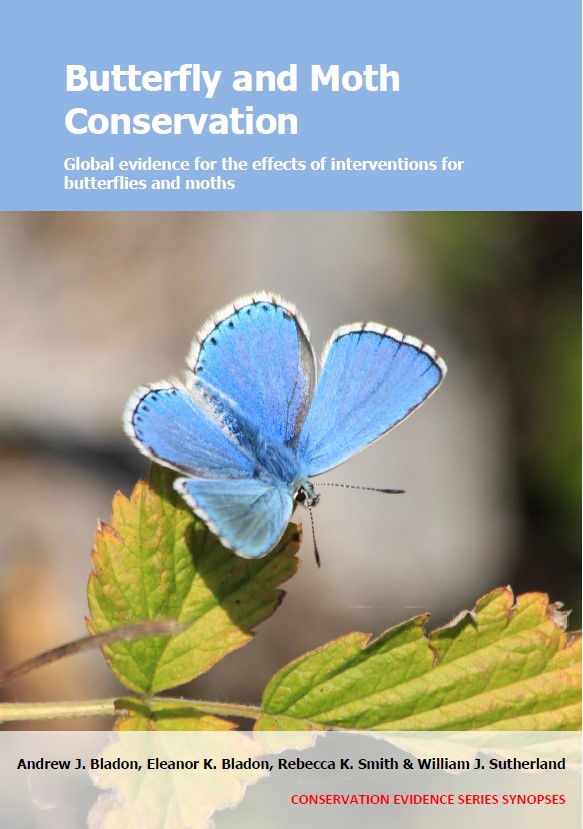Actions to conserve biodiversity
We have summarised evidence from the scientific literature about the effects of actions to conserve wildlife and ecosystems.
Review the evidence from the studies
Not sure what Actions are? Read a brief description.
Search for evidence
e.g. "frogs chytrid"
152 Actions found
Refine
Hide
152 Actions found
Download Actions
| 0 selected |
|
Order results by:
| Action | Effectiveness | Studies | Category | |
|---|---|---|---|---|
|
Create uncultivated margins around intensive arable or pasture fields Action Link |
Evidence not assessed | 10 |
|
|
|
Remove or control non-native or problematic plants Action Link |
Evidence not assessed | 9 |
|
|
|
Employ areas of semi-natural habitat for rough grazing (includes salt marsh, lowland heath, bog, fen) Action Link |
Awaiting assessment | 9 |
|
|
|
Provide or retain set‐aside areas in farmland Action Link |
Awaiting assessment | 9 |
|
|
|
Plant parks, gardens and road verges with appropriate native species Action Link |
Awaiting assessment | 8 |
|
|
|
Restore or maintain species-rich grassland along road/railway verges Action Link |
Evidence not assessed | 8 |
|
|
|
Alter mowing regimes on greenspaces and road verges Action Link |
Evidence not assessed | 7 |
|
|
|
Delay cutting or first grazing date on grasslands to create variation in sward height Action Link |
Awaiting assessment | 7 |
|
|
|
Plant wild bird seed or cover mixture Action Link |
Awaiting assessment | 7 |
|
|
|
Reduce grazing intensity on grassland by seasonal removal of livestock Action Link |
Awaiting assessment | 7 |
|
|
|
Plant new hedges Action Link |
Awaiting assessment | 7 |
|
|
|
Manage land under power lines for butterflies and moths Action Link |
Awaiting assessment | 6 |
|
|
|
Leave headlands in fields unsprayed (conservation headlands) Action Link |
Awaiting assessment | 6 |
|
|
|
Restore or create species-rich, semi-natural grassland Action Link |
Awaiting assessment | 6 |
|
|
|
Use rotational grazing Action Link |
Evidence not assessed | 6 |
|
|
|
Restore or create habitat connectivity Action Link |
Evidence not assessed | 6 |
|
|
|
Thin trees within forests Action Link |
Evidence not assessed | 6 |
|
|
|
Restore or create grassland/savannas Action Link |
Evidence not assessed | 6 |
|
|
|
Restore or create peatland Action Link |
Evidence not assessed | 6 |
|
|
|
Reduce cutting frequency on grassland Action Link |
Awaiting assessment | 6 |
|
|
|
Use prescribed fire to maintain or restore disturbance in forests Action Link |
Evidence not assessed | 5 |
|
|
|
Remove, control or exclude native predators Action Link |
Evidence not assessed | 5 |
|
|
|
Restrict certain pesticides or other agricultural chemicals Action Link |
Awaiting assessment | 5 |
|
|
|
Use ‘warmer’ (red/yellow) lighting rather than other lighting colours Action Link |
Evidence not assessed | 5 |
|
|
|
Increase grazing intensity or cutting frequency on grassland Action Link |
Evidence not assessed | 5 |
|
Download Actions
| 0 selected |
|

Butterfly and Moth Conservation - Published 2023
Butterfly and Moth Synopsis
Watch this search
If you are familiar with RSS feeds, please click the button below to retrieve the feed URL:
RSS feed for this searchIf you are unfamiliar with RSS feeds, we would suggest reading this BBC article.
Unfortunately, due to the number of feeds we have available, we cannot provide e-mail updates. However, you could use tools such as Feed My Inbox to do this for you.
What are 'Individual studies' and 'Actions'?
Individual studies
An individual study is a summary of a specific scientific study, usually taken from a scientific journal, but also from other resources such as reports. It tells you the background context, the action(s) taken and their consequences.
If you want more detail please look at the original reference.
Actions
Each action page focuses on a particular action you could take to benefit wildlife or ecosystems.
It contains brief (150-200 word) descriptions of relevant studies (context, action(s) taken and their consequences) and one or more key messages.
Key messages show the extent and main conclusions of the available evidence. Using links within key messages, you can look at the paragraphs describing each study to get more detail. Each paragraph allows you to assess the quality of the evidence and how relevant it is to your situation.
Where we found no evidence, we have been unable to assess whether or not an intervention is effective or has any harmful impacts.





)_2023.JPG)














